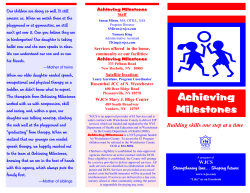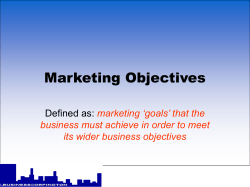
Age-Expected Child Development from Birth to 5 Years
Age-Expected Child Development from Birth to 5 Years The following are resources providing different kinds of information about age-expected skills and behaviors observed in children from birth to five years. Additional resources may be found on the Early Childhood Outcomes Center website (www.the-eco-center.org) in the professional development section under ECO Resources. Albert Einstein College of Medicine (Yeshiva University) (http://www.einstein.yu.edu/) In this public service video for parents, Lisa Shulman, M.D., uses video of babies and toddlers to show the communication milestones expected in typically developing children. She also discusses what parents should do if they suspect their child is developmentally delayed. Watch the video at http://www.youtube.com/watch?v=pZSjm0drIGM. American Academy of Pediatrics (http://www.healthychildren.org/English/agesstages/Pages/default.aspx). Offers health and developmental milestones for different stages, and developmental signs which may need further evaluation. Centers for Disease Control (http://www.cdc.gov/ncbddd/actearly/milestones/index.html) This webpage provides bulleted information on developmental milestones for children from 3 months to 5 years of age and offers developmental warning signs for each age group. The site also offers interactive charts and checklists by age, video on milestones, and select areas of development, and examine expected changes in milestones over time. Colorado Age-Anchoring Resources These materials, developed by Larimer County, CO, provide examples of age-expected development according to the three child outcome areas. They cover child skills and functioning from birth to 36 months. Outcome 1: (http://projects.fpg.unc.edu/~eco/assets/pdfs/Outcome1LarimerCountyAgeAnchoringTool.pdf) Outcome 2: (http://projects.fpg.unc.edu/~eco/assets/pdfs/Outcome2LarimerCountyAgeAnchoringTool.pdf) Outcome 3: (http://projects.fpg.unc.edu/~eco/assets/pdfs/Outcome3LarimerCountyAgeAnchoringTool.pdf)] The Early Childhood Outcomes Center revised April 2015 First Signs (http://www.firstsigns.org/healthydev/healthydev.htm) First Signs is a public awareness and training program addressing early detection and intervention of autism and other developmental disorders. This site provides information on monitoring development, typical milestones, video clips of children with ASD, and tips on sharing concerns. Illinois Child Development Modules: Understanding Young Children's Development Two narrated modules were developed by training personnel in Illinois based on content developed by the University of Connecticut Center for Excellence in Developmental Disabilities. The modules correspond to the child outcome areas and are focused on identifying ageappropriate skills: o Understanding Young Children's Development: A Focus on Positive Social Emotional Skills (https://ucpnet.adobeconnect.com/_a47435447/p59659093/) o Understanding Young Children's Development: Acquiring and Using Knowledge and Skills (https://ucpnet.adobeconnect.com/_a47435447/p9bq60bntyx/) Infant and Toddler Connection of Virginia For children birth to age three: (http://cte.jhu.edu/onlinecourses/HealthyBeginnings/HBFINAL.pdf) The Infant Mental Health Program (IMHP) out of Canada created Comfort, Play & Teach (CPT) materials that include a list of developmental milestones for children birth - 60 months. They are available in both a full set available at http://www.imhpromotion.ca/Portals/0/IMHP%20PDFs/Comfort%20Play%20Teach/CPT%20Ages&Sta gesMilestones_Full%20Set.pdf or in 6 age increments for infants, toddlers and preschoolers available at http://www.imhpromotion.ca/Resources/CPTDevelopmentalMilestones.aspx. IMHP also created a Hand in Hand series resource kit available at http://www.imhpromotion.ca/Resources/HandinHandDevelopmentalSupportPlanning.aspx that provides more detail about social-emotional milestones and help providers identify how to use developmental information to build individualized support plans and activities that support development among children with delays or disabilities. Maryland's Part C Age-Anchored Early Learning Guidelines For children birth to age three: (http://cte.jhu.edu/onlinecourses/HealthyBeginnings/HBFINAL.pdf The National Institute on Deafness and Other Communication Disorders (http://www.nidcd.nih.gov/health/voice/speechandlanguage.asp) This site provides background information on speech and language development from birth to 5 years. Interactive checklists for different ages are available. The Early Childhood Outcomes Center revised April 2015 North Dakota DPI Age Expectation Developmental Milestones (http://www.dpi.state.nd.us/speced1/childhood/full_version%20.pdf) This document was developed by North Dakota's Department of Public Instruction and presents age-expected functioning according to the three child outcomes. They also have a summary version- milestones by age group (http://www.dpi.state.nd.us/speced1/childhood/age_groups%20.pdf) and a three-page milestones quick reference (http://www.dpi.state.nd.us/speced1/childhood/quick_ref.pdf). Parenting Counts Developmental Timeline http://www.parentingcounts.org/information/timeline/ This online resource from Talaris Institute provides research-based information about children’s developmental milestones from birth to age 5. Pathways (http://www.pathwaysawareness.org/awareness/healthcare-professionals/early-motorsurveillance/) An online resource for information and activities related to infant and child development. University of Connecticut Center for Excellence in Developmental Disabilities http://www.uconnucedd.org/ An online training module on social-emotional development in infants and toddlers related to the three OSEP child outcomes. Zero to Three (http://www.zerotothree.org/child-development/) Brain development, challenging behaviors, mental health topics, play, social development, temperament, and more. Each section has interactive tools, parent handouts, tip Sheets, FAQ’s, articles, PowerPoint slides, and other resources. The Early Childhood Outcomes Center revised April 2015
© Copyright 2025











